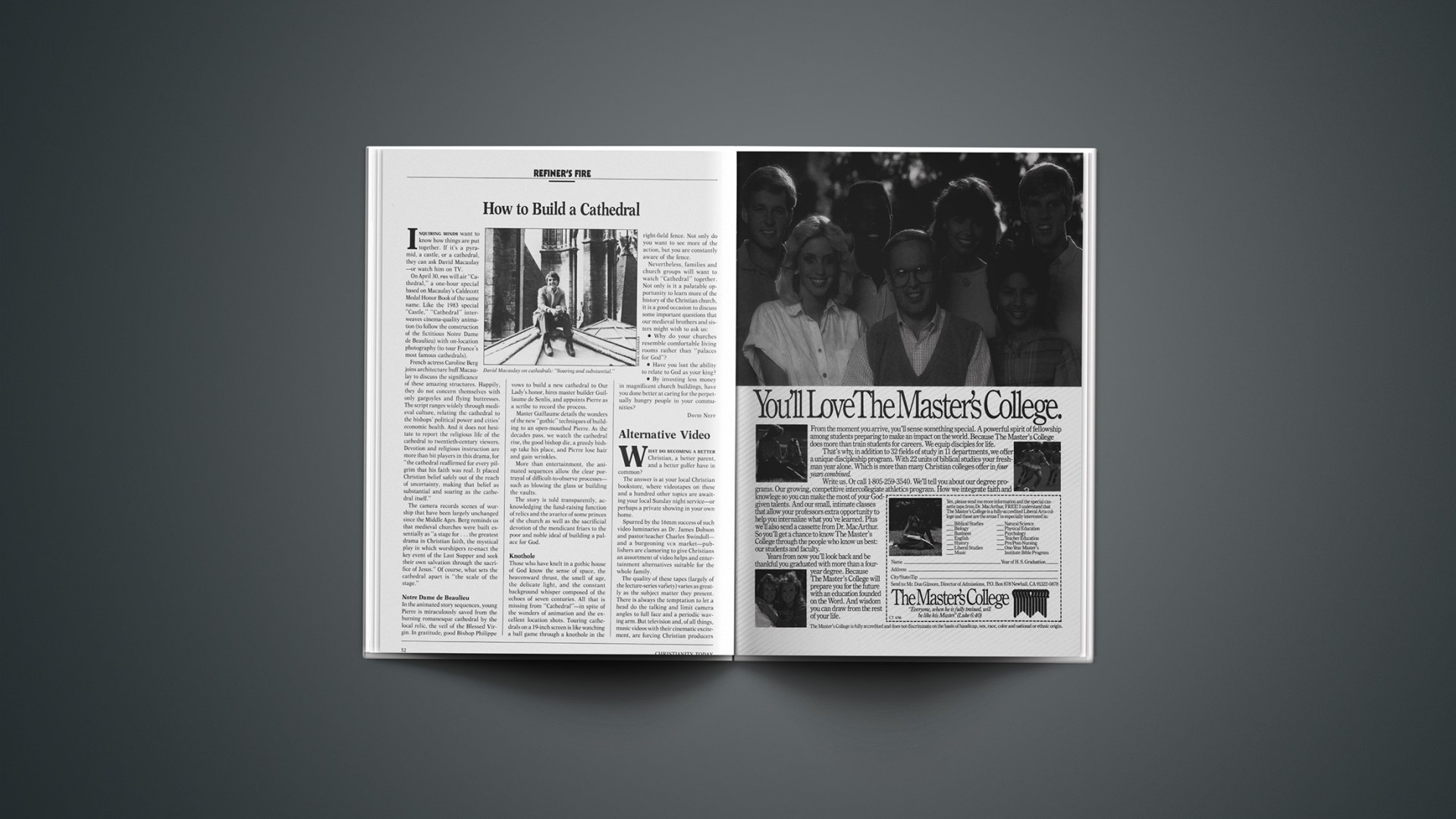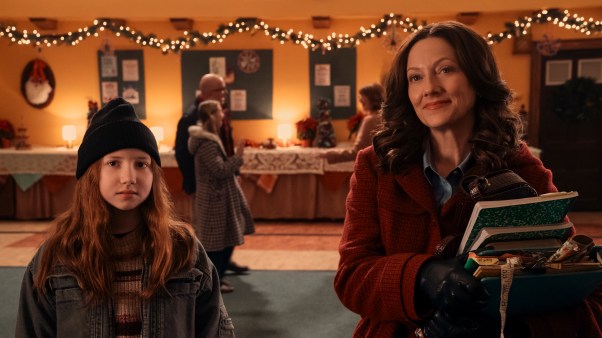Inquiring minds want to know how things are put together. If it’s a pyramid, a castle, or a cathedral, they can ask David Macaulay—or watch him on TV.
On April 30, PBS will air “Cathedral,” a one-hour special based on Macaulay’s Caldecott Medal Honor Book of the same name. Like the 1983 special “Castle,” “Cathedral” interweaves cinema-quality animation (to follow the construction of the fictitious Notre Dame de Beaulieu) with on-location photography (to tour France’s most famous cathedrals).
French actress Caroline Berg joins architecture buff Macaulay to discuss the significance of these amazing structures. Happily, they do not concern themselves with only gargoyles and flying buttresses. The script ranges widely through medieval culture, relating the cathedral to the bishops’ political power and cities’ economic health. And it does not hesitate to report the religious life of the cathedral to twentieth-century viewers. Devotion and religious instruction are more than bit players in this drama, for “the cathedral reaffirmed for every pilgrim that his faith was real. It placed Christian belief safely out of the reach of uncertainty, making that belief as substantial and soaring as the cathedral itself.”
The camera records scenes of worship that have been largely unchanged since the Middle Ages. Berg reminds us that medieval churches were built essentially as “a stage for … the greatest drama in Christian faith, the mystical play in which worshipers re-enact the key event of the Last Supper and seek their own salvation through the sacrifice of Jesus.” Of course, what sets the cathedral apart is “the scale of the stage.”
Notre Dame De Beaulieu
In the animated story sequences, young Pierre is miraculously saved from the burning romanesque cathedral by the local relic, the veil of the Blessed Virgin. In gratitude, good Bishop Philippe vows to build a new cathedral to Our Lady’s honor, hires master builder Guillaume de Senlis, and appoints Pierre as a scribe to record the process.
Master Guillaume details the wonders of the new “gothic” techniques of building to an open-mouthed Pierre. As the decades pass, we watch the cathedral rise, the good bishop die, a greedy bishop take his place, and Pierre lose hair and gain wrinkles.
More than entertainment, the animated sequences allow the clear portrayal of difficult-to-observe processes—such as blowing the glass or building the vaults.
The story is told transparently, acknowledging the fund-raising function of relics and the avarice of some princes of the church as well as the sacrificial devotion of the mendicant friars to the poor and noble ideal of building a palace for God.
Knothole
Those who have knelt in a gothic house of God know the sense of space, the heavenward thrust, the smell of age, the delicate light, and the constant background whisper composed of the echoes of seven centuries. All that is missing from “Cathedral”—in spite of the wonders of animation and the excellent location shots. Touring cathedrals on a 19-inch screen is like watching a ball game through a knothole in the right-field fence. Not only do you want to see more of the action, but you are constantly aware of the fence.
Nevertheless, families and church groups will want to watch “Cathedral” together. Not only is it a palatable opportunity to learn more of the history of the Christian church, it is a good occasion to discuss some important questions that our medieval brothers and sisters might wish to ask us:
• Why do your churches resemble comfortable living rooms rather than “palaces for God”?
• Have you lost the ability to relate to God as your king?
• By investing less money in magnificent church buildings, have you done better at caring for the perpetually hungry people in your communities?
DAVID NEFF
What do becoming a better Christian, a better parent, and a better golfer have in common?
The answer is at your local Christian bookstore, where videotapes on these and a hundred other topics are awaiting your local Sunday night service—or perhaps a private showing in your own home.
Spurred by the 16mm success of such video luminaries as Dr. James Dobson and pastor/teacher Charles Swindoll—and a burgeoning VCR market—publishers are clamoring to give Christians an assortment of video helps and entertainment alternatives suitable for the whole family.
The quality of these tapes (largely of the lecture-series variety) varies as greatly as the subject matter they present. There is always the temptation to let a head do the talking and limit camera angles to full face and a periodic waving arm. But television and, of all things, music videos with their cinematic excitement, are forcing Christian producers to play their creative hand.
Some of their latest offerings:
• Over 50 million people saw the Focus on the Family series by Dr. James Dobson. It is little wonder, then, that Word, Inc., is anticipating a large response to the psychologist’s new series, Turn Your Heart Toward Home. The first segment of the series, titled A Father Looks Back, is available on videotape and features Dobson reflecting upon middle age and life’s lessons learned—especially those relating to parenting.
His “let’s get close” manner and nonstop humor make this “talking-head” surprisingly entertaining.
• The six-part series Ordering Your Private World (Thomas Nelson Communications), featuring Inter-Varsity president Gordon MacDonald, mixes docudrama and location shooting in discussing how to organize the spiritual life.
• Also from Thomas Nelson, three new titles in their University Lecture Series: “The Holy Spirit and Ourselves” with J. I. Packer; “I Thessalonians: The Gospel and the Church” with John Stott; and “II Timothy: A Call to Greatness” with Ray Stedman.
• Evangelism has been a cornerstone of Christian film since the beginning. Not surprisingly, then, ways of reaching the lost are also being taught via videotape. One such effort is Multnomah’s Lifestyle Evangelism series. Featuring a low-key Joseph Aldrich, president of Multnomah School of the Bible, the series uses an interplay of long, medium, and close-up shots, and an occasional electronic graphic to help hold viewer attention.
• Bringing biblical truths to the cartoon crowd is the thrust of Tyndale’s new Flying House video series. Up to 52 videos are planned, showing animated children time-tripping back to New Testament times.
The Tyndale children’s series underscores what may well be the largest, untapped area for Christian video producers—the development of quality entertainment not based upon somebody’s six lectures. Few Christian films are even available on video (although Worldwide Pictures has begun a “classics” film series).
For the time being, then, we must content ourselves with a steadily growing catalog of “helps” that are becoming more readily accessible as Americans welcome video playback machines into their homes and churches.
HAROLD SMITH










